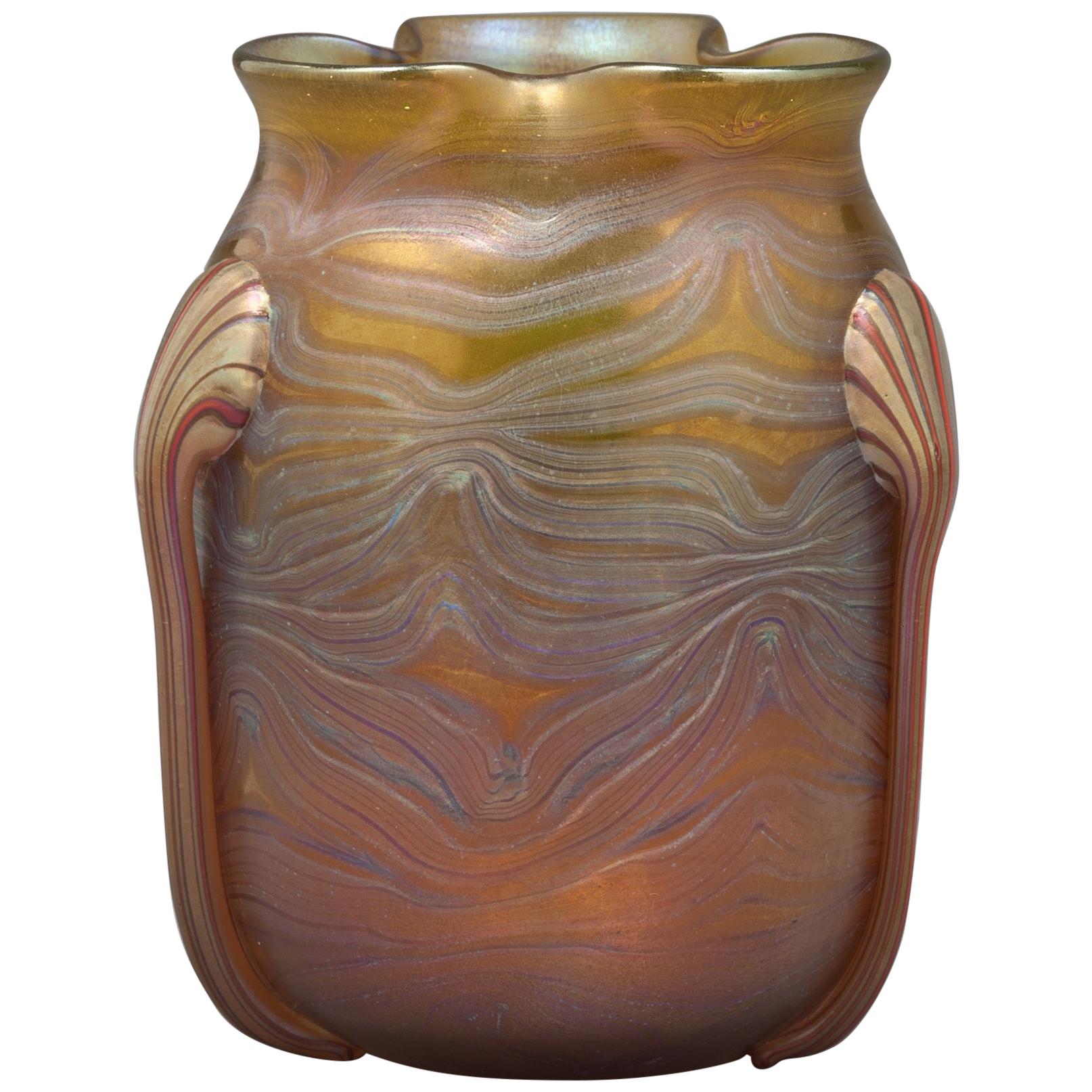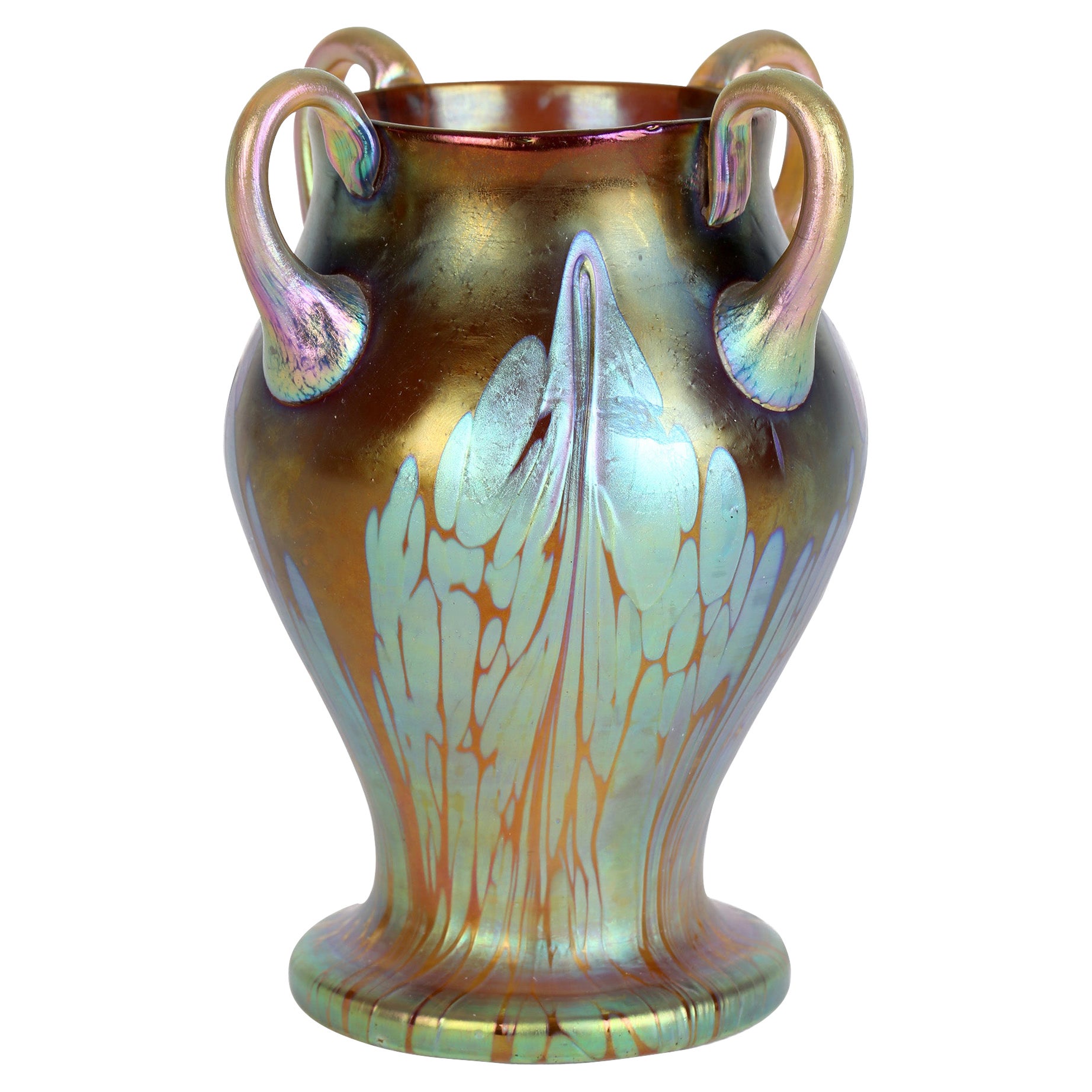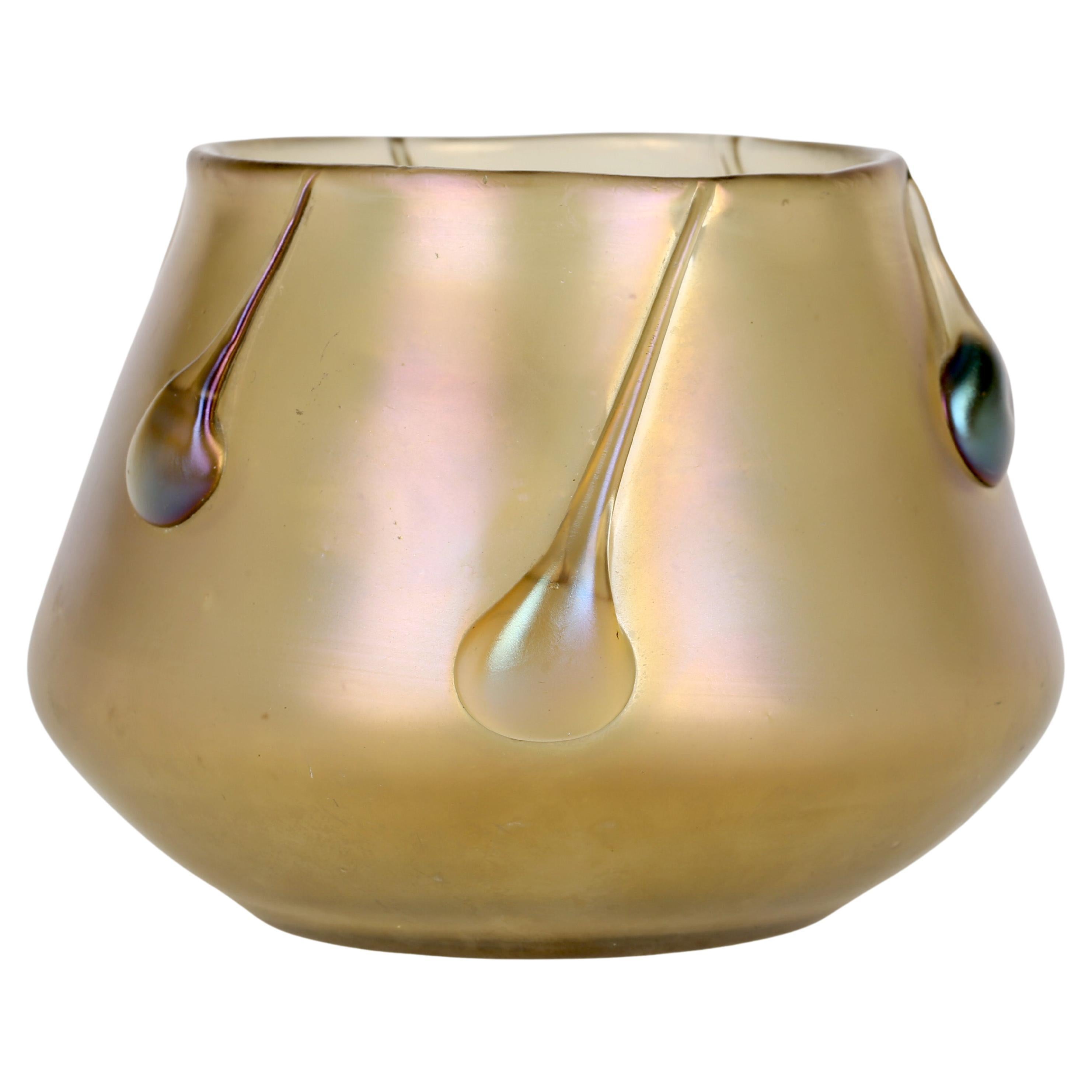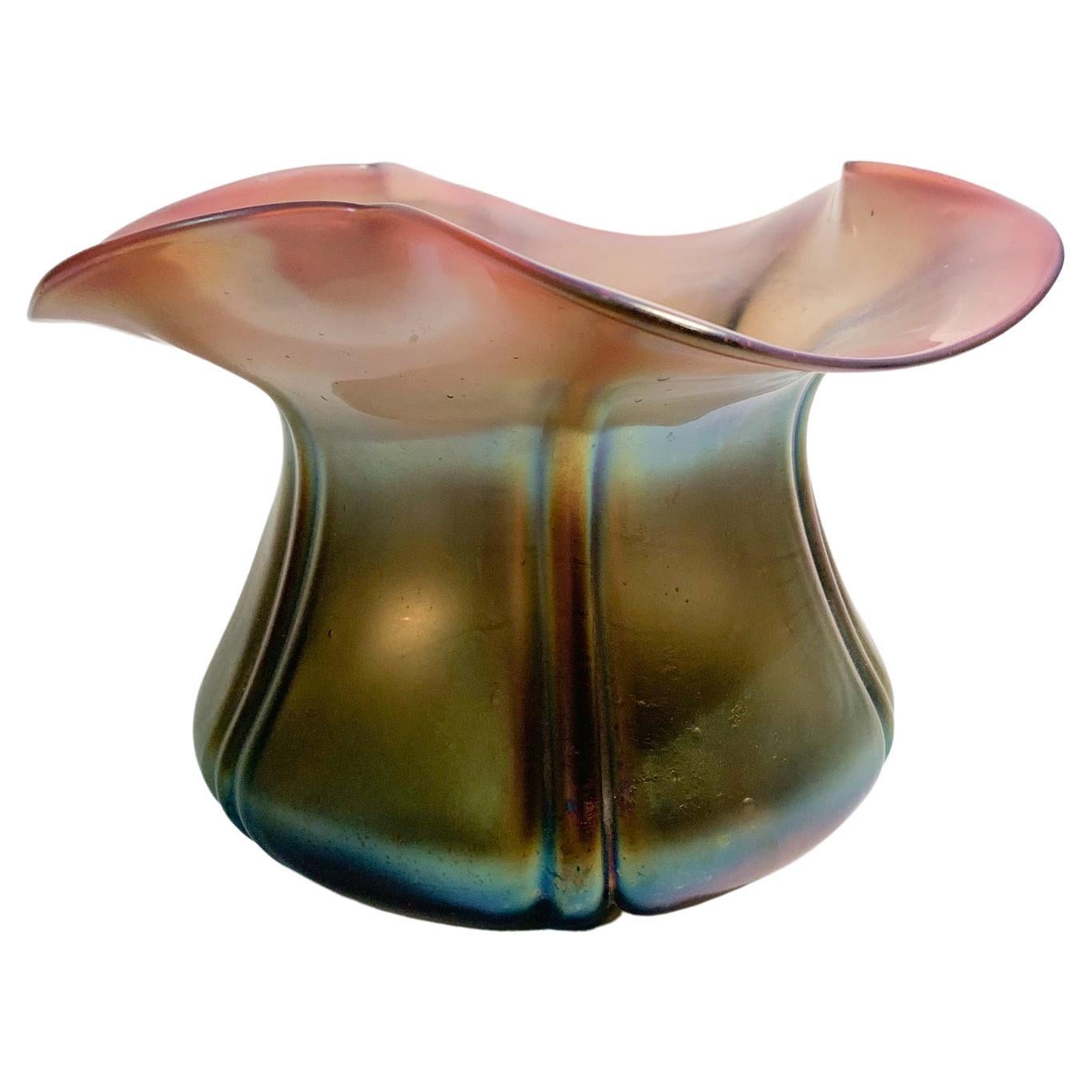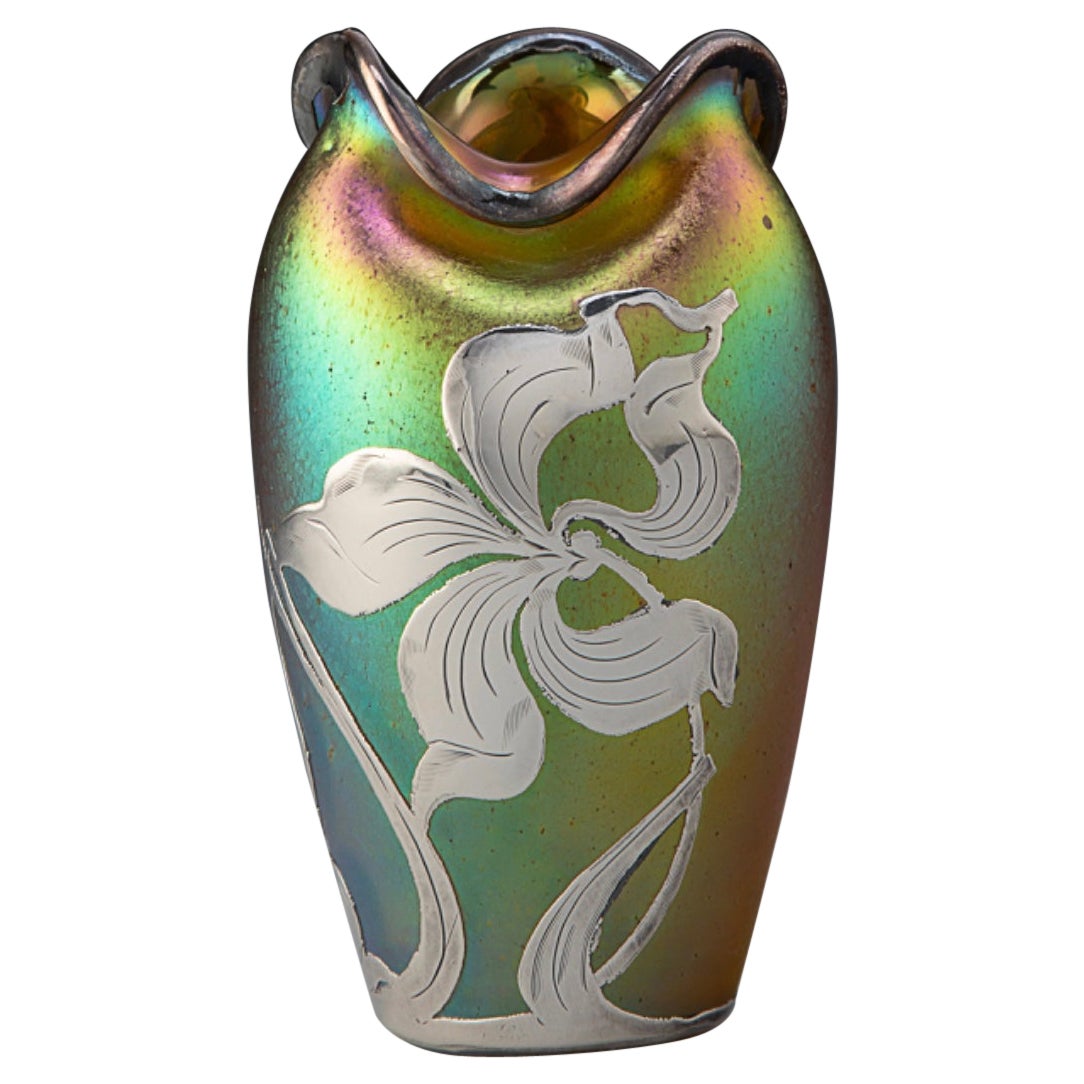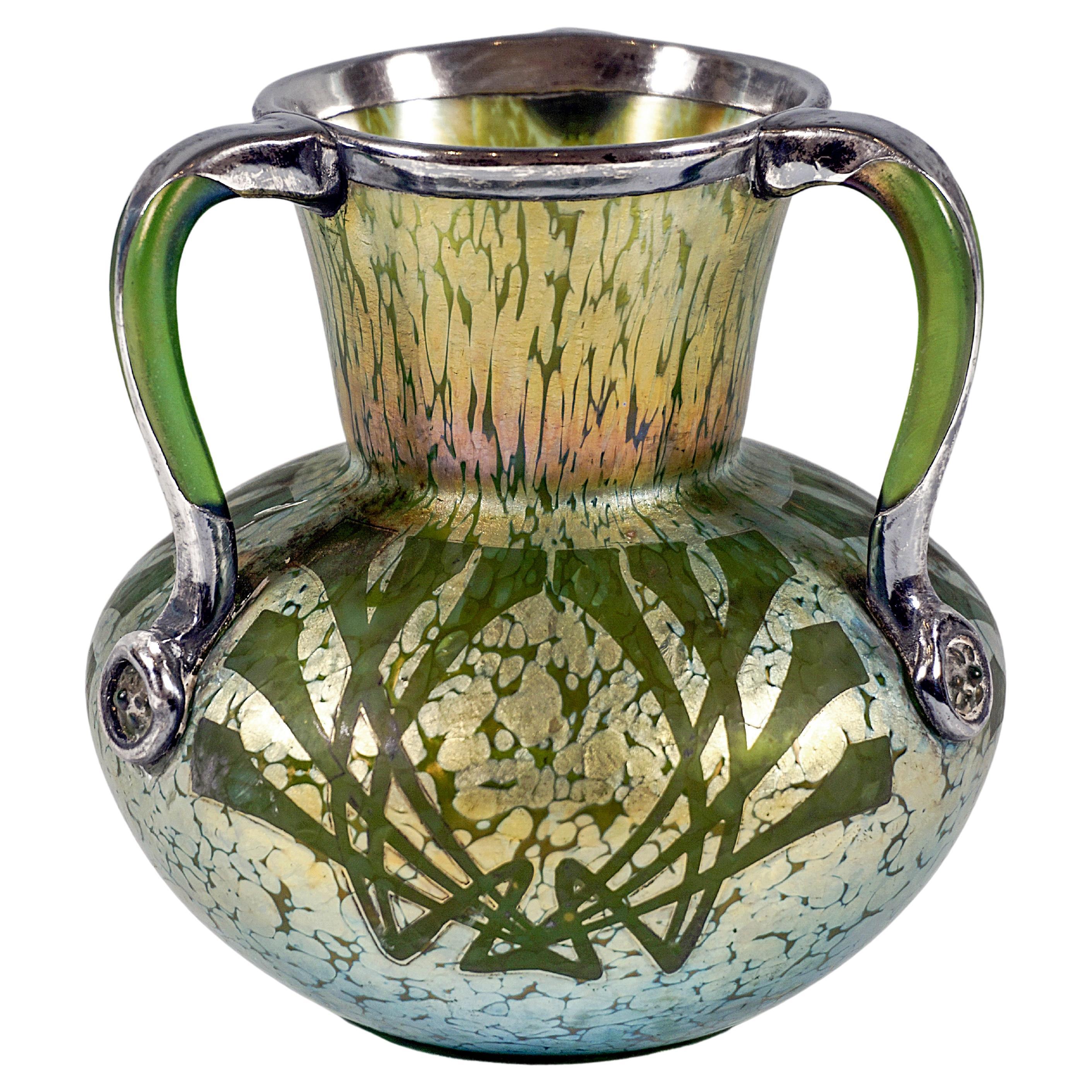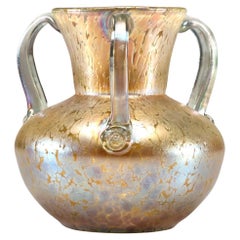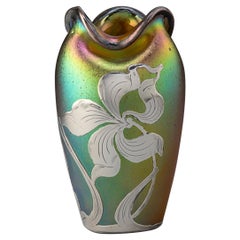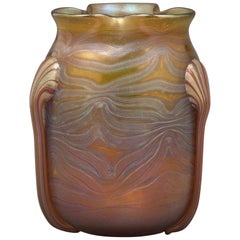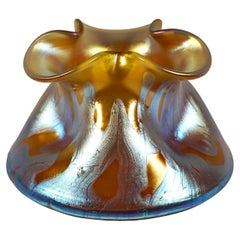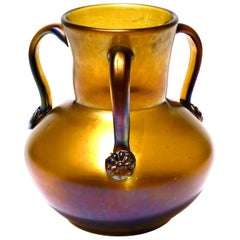
Loetz Glatt Bronze Three Handled Glass Vase
View Similar Items
Loetz Glatt Bronze Three Handled Glass Vase
About the Item
- Creator:Loetz Glass (Manufacturer)
- Dimensions:Height: 6.5 in (16.51 cm)Diameter: 6 in (15.24 cm)
- Style:Art Nouveau (Of the Period)
- Materials and Techniques:Art Glass,Fired
- Place of Origin:
- Period:1900-1909
- Date of Manufacture:1900
- Condition:Wear consistent with age and use.
- Seller Location:Dallas, TX
- Reference Number:1stDibs: LU1774234835132
Loetz Glass
Best known to collectors for their magnificent Marmoriertes and Phänomen glass creations, the Loetz Glass company was a leading Art Nouveau producer of fine glass vases, bowls and other decorative objects through the mid-19th and early 20th centuries.
Shortly before his death in 1855, attorney Frank Gerstner transferred sole ownership of his glassworks company to his wife Susanne. The company, which was founded in what is now the Czech Republic in 1836 by Johann Eisner, was renamed Johann Loetz Witwe by Susanne Gerstner as a tribute to her late husband who preceded Gerstner, a glassmaker named Johann Loetz (Loetz was also known as Johann Lötz).
For 20 years, Gerstner led the company, expanding its manufacturing and distribution capacity. It proved profitable, but the glassworks' popularity didn't start gaining significant momentum until after Gerstner transferred sole ownership to her grandson Maximilian von Spaun in 1879.
Von Spaun and designer Eduard Prochaska developed innovative techniques and solutions for reproducing historical styles of decorative glass objects, such as the very popular marbled Marmoriertes glass — a technique that lends glass an appearance that is similar to semi-precious stones such as onyx or malachite. Under von Spaun’s leadership, the firm’s works garnered them success in Brussels, Vienna and Munich, and Johann Loetz Witwe won awards at the Paris World Exposition in 1889. In 1897 von Spaun first saw Favrile glass in Bohemia and Vienna.
The work in Favrile glass, a type of iridescent art glass that had recently been developed and patented by Louis Comfort Tiffany, founder of iconic American multimedia decorative-arts manufactory Tiffany Studios, inspired von Spaun to explore the era’s burgeoning Art Nouveau style — or, as the firm was established in a German-speaking region, the Jugendstil style.
The company partnered with designers Hans Bolek, Franz Hofstötter and Marie Kirschner and thrived until von Spaun passed it down to his son, Maximilian Robert.
With the Art Deco style taking shape around the world, the company was unable or unwilling to adapt to change. Loetz Glass collaborated with influential names in architecture and design, including the likes of Josef Hoffmann, a central figure in the evolution of modern design and a founder of the Vienna Secession. Unfortunately, the glassworks’ partnerships did them little good, and the company’s mounting financial problems proved difficult to navigate. Two World Wars and several major fires at the glassworks took their toll on the firm, and in 1947 the Loetz Glass Company closed its doors for good.
Today the exquisite glass produced by Loetz Glass Company remains prized by collectors and enthusiasts alike.
On 1stDibs, find antique Loetz Glass Company glassware, decorative objects and lighting.
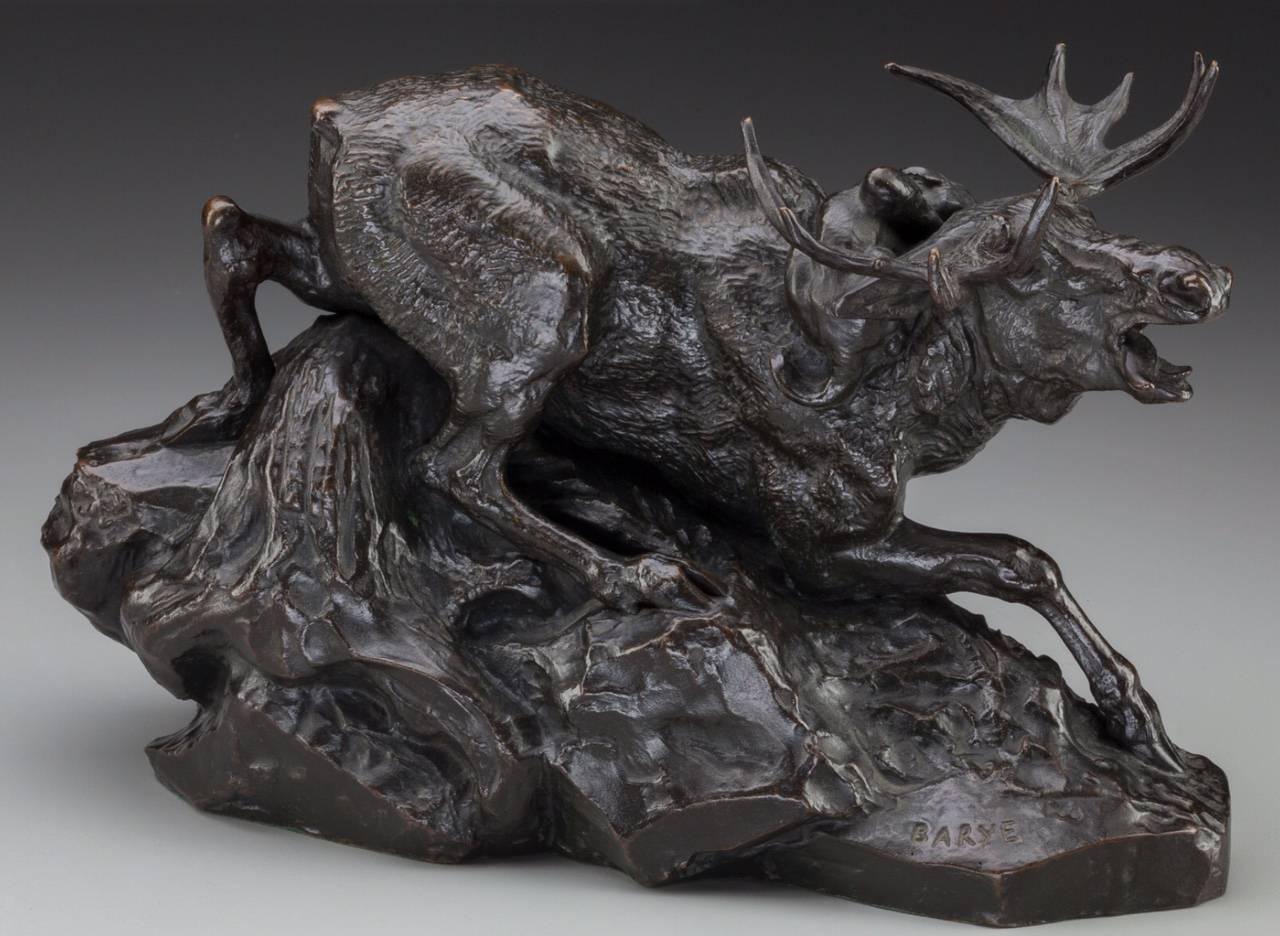
- Loetz Candia Papillon Three Handled VaseBy Loetz GlassLocated in Dallas, TXLoetz Candia Papillos three handled vase. Austria Circa 1910 Measures: Height: 5.75 inches Diameter: 5.5 inches Condition Excellent with no issues. AVANTIQUES is dedicated to providing an exclusive curated collection of Fine Arts, Paintings, Bronzes, Asian treasures, Art Glass and Antiques. Our inventory represents time-tested investment quality items with everlasting decorative beauty. We look forward to your business and appreciate any reasonable offers. All of our curated items...Category
Vintage 1910s Austrian Art Nouveau Vases
MaterialsArt Glass
- Loetz Rubin Matte Iris Handles Ewer Vase, Rare 1898By Loetz GlassLocated in Dallas, TXLoetz Rubin Matte Iris - 1898 (aka: rubin metall) Registered Model: PM I-7875 Ruby ground; metallic-bronze iridescent finish (iris) with purple highlights. Measures: Height 7.75 inches Width 4.25 inches Condition: Excellent AVANTIQUES is dedicated to providing an exclusive curated collection of Fine Arts, Paintings, Bronzes, Asian treasures, Art Glass and Antiques. Our inventory represents time-tested investment quality items with everlasting decorative beauty. We look forward to your business and appreciate any reasonable offers. All of our curated items are vetted and guaranteed authentic and as described. Avantiques only deals in original antiques and never reproductions. We stand behind our treasures with a full money back return if the items are not as described. In 1836, Johann Eisner established a glassworks in the Southern Bohemian town of Klostermühle, today part of the Czech Republic and called Klášterský Mlýn. His heirs sold the glassworks to Martin Schmid in 1849, and two years later Schmid sold it to Frank Gerstner, attorney-at-law, and his wife Susanne. Susanne was the widow (‘Witwe’ in German) of Johann Loetz, a glassmaker about whom we know very little. Gerstner transferred sole ownership to Susanne shortly before his death in 1855, and she successfully led and expanded the company during the subsequent 20 years, manufacturing mainly crystal, overlay and painted glass. In 1879, Susanne transferred the company – now called ‘Johann Loetz Witwe’ – to Maximilian von Spaun, the son of her daughter Karoline. One year later, von Spaun hired Eduard Prochaska and the two of them modernized the factory and introduced new, patented techniques and processes. The Historicist Period The first fruits of this collaboration were exciting innovations in Historicism glass, including Intarsia and Octopus glass and the very popular marbled (‘marmorisierte’) glass which imitated semi-precious stones like red chalcedony, onyx and malachite. Success at exhibitions in Brussels, Munich and Vienna were crowned by awards at the Paris World’s Exposition in 1889. In 1897, von Spaun first saw Tiffany Favrile glass exhibited in Bohemia and Vienna, and this convinced him that the art nouveau style was also the way to go for Loetz Witwe. The next eight years were to be the most artistically significant and profitable period in the entire history of the company. The Art Nouveau Period – the Glory Years Loetz Paris-Expo1900Loetz Paris-Expo1900The glassworks created large numbers of its own new designs of iridescent, trailing art nouveau glass, sometimes in collaboration with well-known artists and designers like Marie Kirschner and Franz Hofstötter (aka Franz Hofstätter). The zenith of Loetz art nouveau glass was epitomized by the so-called Phänomen series of designs, much of it designed by Hofstötter, which won a Grand Prix (alongside Tiffany, Gallé, Daum and Lobmeyr) at the Paris World’s Exposition in 1900. The company’s success during this period had two prime drivers – the technical expertise of Prochaska and the business acumen of von Spaun. Loetz Witwe created many of its own designs, and also supplied glass commissioned by major customers like E. Bakolowits (Vienna) and Max Emanuel...Category
Antique 1890s Czech Art Nouveau Vases
MaterialsArt Glass
- Loetz Candia Silberiris Glass Vase with Silver OverlayBy Loetz GlassLocated in Dallas, TXLoetz Candia Silberiris Glass Vase with Silver Overlay Circa 1900 Height: 5.2 inches (13.0 cm) Diameter: 3 Inches (7.5 cm) Condition: Glass vas...Category
Antique Early 1900s Czech Art Nouveau Vases
MaterialsArt Glass
- Loetz Candia Papillon Art Nouveau VaseBy Loetz GlassLocated in Dallas, TXLoetz Iridescent and oil spot Flared Neck Art glass Floriform Goose neck vase. Candia Papillon vase Austria Iridescent glass Unsigned Circa 1898 A...Category
Antique 1890s Czech Art Nouveau Vases
MaterialsArt Glass
- Loetz Cobalt Papillon Art Nouveau VaseBy Loetz GlassLocated in Dallas, TXThis Loetz vase in the Cobalt Papillon pattern has blue iridescent Papillon design covering the exterior of the vase. Vase is signed on the polished ...Category
Antique Early 1900s Austrian Art Nouveau Vases
MaterialsArt Glass
- Loetz Cobalt Papillon Art Nouveau VaseBy Loetz GlassLocated in Dallas, TXA Loetz Cobalt Papillon Art Glass and Pewter Art Nouveau Vase. Circa 1900 The shapely design with flared base having four evenly spaced indentations...Category
Antique Early 1900s Czech Art Nouveau Vases
MaterialsPewter
- Loetz Glass Vase with Applied Handles, circa 1910By Loetz GlassLocated in New York, NYWith applied pull design. Signed Loetz.Category
Early 20th Century Austrian Vases
MaterialsArt Glass
- Loetz Art Nouveau Four Handled Phaenomen Iridescent Art Glass VaseBy Loetz GlassLocated in Bishop's Stortford, HertfordshireAn exceptional and rare Bohemian art nouveau Phenomen Genre 2/484 (also known as Medici) pattern Loetz vase dating from around 1902. This beautiful vase stands on a rounded spread fo...Category
Antique Early 1900s Austrian Art Nouveau Vases
MaterialsBlown Glass
- Loetz Art Nouveau Glass Vase Bronze Phenomenon Genre 29, Austria-Hungary, C 1900By Loetz GlassLocated in Vienna, ATFinest Bohemian Art Nouveau Glass Vase: In shape blown low, cambered body on a large, round floor plan, triple indented wall with a mouth rim formed into a three-pass shape, polished...Category
Antique Early 1900s Austrian Art Nouveau Glass
MaterialsGlass
- Loetz Vesuvian Candia Iridescent Glass Vase with TadpolesBy Loetz GlassLocated in Bishop's Stortford, HertfordshireStylish Bohemian Vesuvian Candia iridescent glass vase with tadpoles by Johann Loetz Witwe and dating from around 1901. The simply shaped wide v...Category
Antique Early 1900s Austrian Art Nouveau Vases
MaterialsBlown Glass
- Kralik/Loetz White Opalescent Textured Art Glass VaseBy Loetz GlassLocated in Bishop's Stortford, HertfordshireA very fine quality Art Nouveau Austrian or Bohemian opalescent art glass egg shaped vase with shaped and pinched flower shaped opening attributed to Kralik or possibly Loetz and dat...Category
Antique Early 1900s Austrian Art Nouveau Vases
MaterialsBlown Glass
- Iridescent Loetz Glass Vase with Flower Opening, 1940sBy Loetz GlassLocated in Milano, MIVase in Austrian iridescent Loetz glass, with a shape with a flower opening and colors from purple to beetle, made in the 1940s Measures: Ø cm 18 h cm 11 The production of Loetz glass began with Johan Loetz (1778-1848) in the 18th century through the takeover of the Klostermühle glassworks. In the second half of the 19th century, his nephew took charge of the modernization of the glassworks, introducing, thanks to the assistance of the inventor Eduard Prochaska, new processing techniques: thus new processes were born with glass in imitation of semi-precious stones, veins and the decoration. , which during processing includes hot coils or colored glass pads. Finally, at the end of the 19th century, the creation of the first glass iridescences with metallic reflections began, up to the creation of Phänomen in glass with applications and inserts of partially metallized glass filaments, similar to Tiffany glass and the famous Papillon glass...Category
Vintage 1940s Austrian Art Nouveau Vases
MaterialsGlass
$661 Sale Price20% Off

